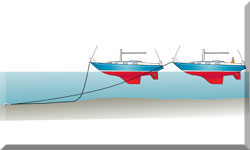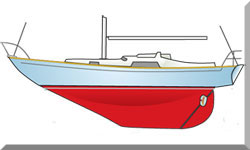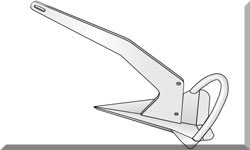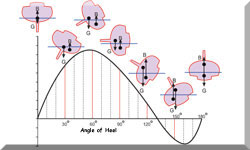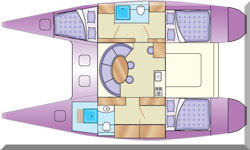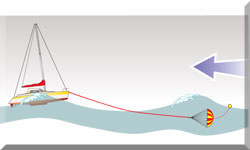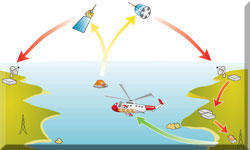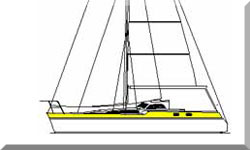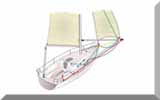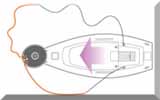- Home
- Electrical Systems
Marine Electrical Systems for Sailboats
Modern sailboats bristle with electrical equipment. Not just the essential items associated with the safe running of the boat, but also those 'nice-to-haves' more aligned with home comforts.
But have you ever wondered what keeps all these gadgets and systems running smoothly? Let's dive into the critical components and considerations that make up the lifeline of your sailboat's electrical infrastructure...
Batteries: The Heart of the System
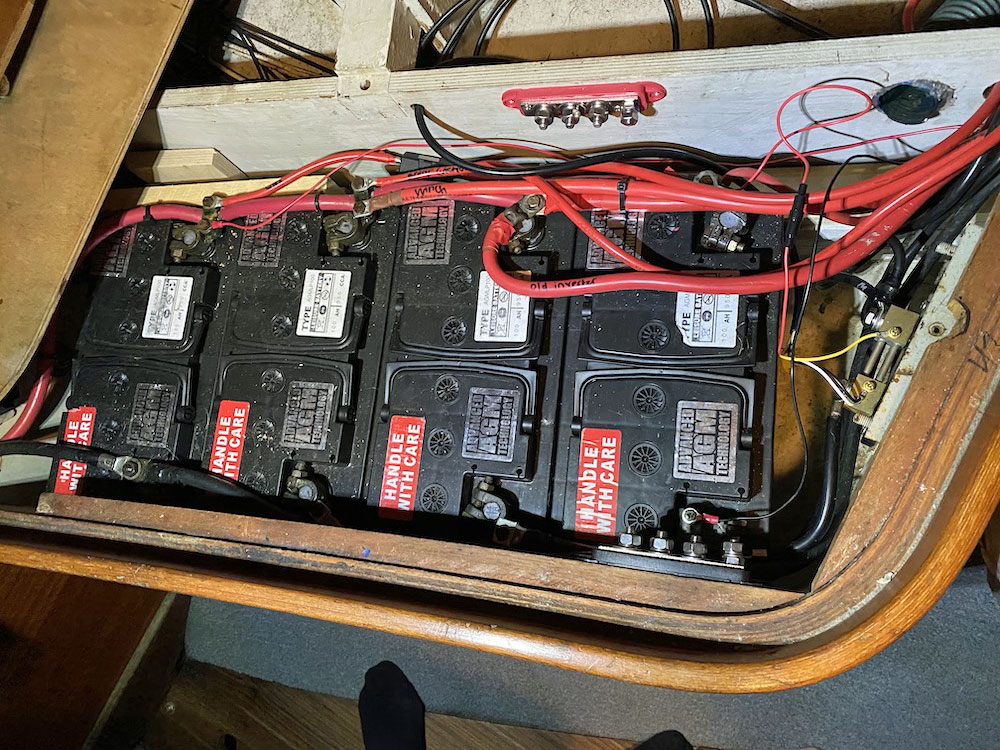 A sizable domestic bank of AGM batteries
A sizable domestic bank of AGM batteriesAt the heart of any marine electrical system are the batteries. These powerhouses store and supply direct current (DC) to all electrical devices on the boat.
There are two main types of batteries at the core of this system:
- Starter batteries, and
- Deep Cycle batteries
Starter batteries are the sprinters, delivering a powerful burst of energy to kick your engine into action. They provide high current quickly, ensuring smooth engine starts every time you turn the key.
Deep cycle batteries, on the other hand, are the marathon runners. They supply a steady, prolonged flow of power to your boat's electronics and accessories—from navigation systems and radios to lights and refrigerators.
Understanding the roles of these batteries ensures each system receives the appropriate power, enhancing performance and extending equipment life.
Lead-acid batteries are the tried-and-true workhorses of marine electrical systems, offering reliability and affordability. AGM (Absorbent Glass Mat) batteries, with their sealed design, provide added safety and longevity. Lithium-ion batteries, while pricier, offer superior performance and energy density, making them a popular choice for modern sailors who demand the best.
But these different battery types each have their pros and cons...
Energy Generation: The Alternator
When your sailboat’s engine is running, the alternator becomes a key player. Connected to the engine, it charges the batteries through a regulator and supplies power to the boat's electrical systems. Think of the alternator as a mini power plant that kicks into gear every time your engine roars to life. Regular maintenance and proper functioning of the alternator are crucial to prevent unexpected power failures, especially when you're far from shore. Keeping an eye on the alternator's belts and connections ensures it remains in top condition.
But not all alternators and regulators are equal...
A production boat, straight out of the box, will have an engine driven alternator for charging the boat batteries. Coupled with a shore-power marine onboard battery charger this will be adequate for inshore sailing between marina berths.
On longer offshore passages far from the plug-in convenience of a marina berth, it might not be. An independent diesel-powered generator if you've got room for it would be a good backup system and would provide all the power you need, but:
- They're heavy;
- They use fuel;
- They can be noisy (and smelly);
- They pollute the atmosphere.
Whereas marine solar panels, windchargers and towed water turbine generators have no such downsides.
Network of Connections: Wiring
Wiring acts as the circulatory system, distributing power throughout the boat. Quality marine-grade 'tinned' wiring is essential to withstand the harsh marine environment, where exposure to moisture and salt can lead to corrosion and potential electrical hazards. Properly labelled and organized wiring simplifies troubleshooting and maintenance. Investing in high-quality connectors and ensuring that all connections are secure can prevent a host of electrical issues down the line.
Control and Protection: Switches and Circuit Breakers
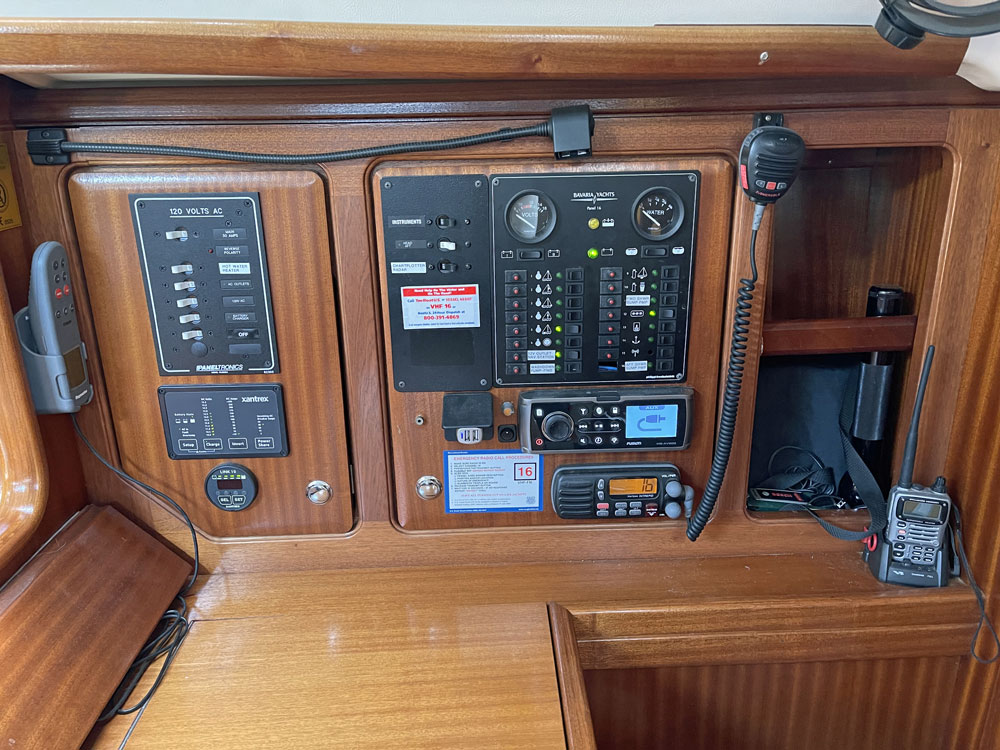 A typical AC and 12v DC control panel at the nav station of this Bavaria 40
A typical AC and 12v DC control panel at the nav station of this Bavaria 40Switches control the flow of electricity, allowing you to turn devices on and off as needed. Circuit breakers, on the other hand, protect the electrical system from overloads. In the event of a surge, these breakers cut off the power supply, preventing damage and ensuring safety. It's crucial to regularly inspect and test these components to maintain system integrity. Modern marine electrical panels often come with built-in indicators that can alert you to potential issues before they become major problems.
DC and AC Systems: Complementary Powers
Most sailboats operate primarily on DC power, providing energy for essential devices like navigation lights, radios, and instruments. However, larger vessels or those with shore power connections may incorporate alternating current (AC) systems for appliances such as air conditioning units and refrigerators. Understanding the interaction between DC and AC systems ensures a smooth and efficient power management experience on board. Devices like inverters can convert DC power to AC, allowing you to run household appliances off your boat's battery bank when needed.
Safety Net: Grounding and Bonding
Safety on the water extends to your boat’s electrical systems. Proper grounding provides a path for electrical faults to discharge safely into the water, reducing the risk of electric shock. Bonding, on the other hand, involves connecting metallic components to create a common electrical reference point. This minimizes corrosion and eliminates stray electrical currents that could pose a threat to your vessel's integrity. Ensuring that all metal parts, including through-hull fittings and tanks, are properly bonded can prevent galvanic corrosion and extend the life of your boat's hardware.
Modern Innovations: Digital Switching and Electric Propulsion
Advancements in marine technology have introduced digital switching, allowing for programmable overcurrent protection devices. This technology can sense current and log values, enhancing system diagnostics. However, it's essential to recognize that the failure of the main control unit in a digital system could lead to system-wide issues. Regular software updates and backups can mitigate these risks.
Electric propulsion is another modern innovation, offering an eco-friendly alternative to traditional engines. Electric motors are quieter, produce no exhaust fumes, and require less maintenance. However, transitioning to electric propulsion requires a thorough understanding of power generation and storage to ensure that your sailboat's performance remains uncompromised. Installing solar panels or wind generators can help supplement your power needs and extend your cruising range.
Daily Power Management: Calculating Amp Requirements
To maintain an efficient electrical system, it’s vital to calculate the daily amp requirements of your boat. This involves listing all onboard electrical equipment and applying a current rating to each item. By understanding the relationship between power (watts), current (amperes), and system voltage (volts), you can accurately assess your boat's power needs and make informed decisions about battery capacity and energy consumption. Using a power management app or monitoring system can help you track and optimize your energy use in real-time.
Assessing the current draw and sizing the appropriate battery bank...
Summary
Understanding your boat’s electrical system is key to safe and enjoyable sailing. From the batteries that store energy to the alternators that generate it, and from the wiring that connects everything to the safety measures that protect it, each component plays a vital role. Modern innovations like digital switching and electric propulsion are pushing the boundaries, but a solid grasp of the basics remains essential. With careful planning and regular maintenance, your sailboat’s electrical system will power your adventures on the open water with reliability and safety.
Recent Articles
-
How a Marine EPIRB Can Get You into Trouble, As Well As Out Of It
Apr 12, 25 05:51 PM
Activating a marine EPIRB or a Personal Locator Beacon (PLB) when you're not in distress can get you in big trouble with the Coastguard, as this cautionary tale relates. -
What is an EPIRB?
Apr 12, 25 05:43 PM
Got any EPIRB-related questions? You're almost certain to find the answers here... -
What is a Chartplotter? Your Questions Answered
Apr 12, 25 04:48 AM
Got any questions about marine GPS chartplotters? Odds are, you'll find your answer here...

